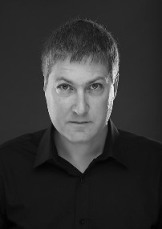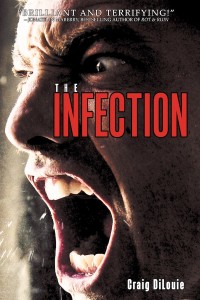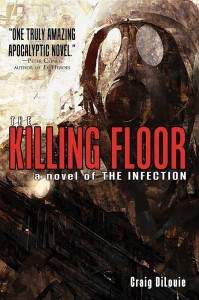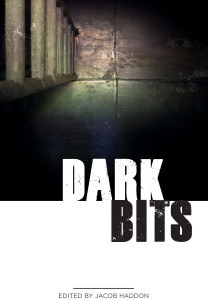Guest Post by Craig DiLouie

I enjoy writing horror because it allows a writer to really stretch and go way beyond standard norms and reader comfort zones. But what makes a good horror story?
First, let’s define horror fiction. Wikipedia defines it as a genre of literature that is intended to “scare or startle readers by inducing feelings of horror and terror.”
In other words, it’s fiction that produces feelings associated with horror-what Merriam-Webster defines as “painful and intense fear, dread or dismay”-in the reader. The Horror Writers Association essentially agrees with this definition.
I do as well, though I would add that effective characterization is so important to achieving the goal that it should be part of the definition. Why? Horror is more likely to be realized by the reader when there is a character, with whom they can relate, experiencing it at the same time. In this way, certain characters in the story are intended to stand in for the reader.
Character is doubly important when one considers the fact horror is a very subjective emotion. Some of us find the sight of blood horrifying, while others don’t. Some of us tremble and sweat at the slightest turbulence on an airplane, while others barely notice it. If the author can put the reader in the protagonist’s shoes, they should experience feelings of horror through empathy even if they themselves don’t find the object of the protagonist’s horror that scary or dreadful.
Before we continue, we should probably ask the question: Why would anybody want to actually experience this? Horror is, after all, horrifying.
is, after all, horrifying.
In Thrill Seekers Thrive on The Scary, published on WebMD.com, Dr. Frank Farley, psychologist at Temple University, says people can satisfy their curiosity about and fascination with the frightening, the bizarre, the unusual, and make sense of it. Dr. Glenn Sparks, professor of communications at Perdue University, believes people have a basic need to seek out situations outside their comfort zone. In some cases, they want to confront danger in order to conquer it.
Then there are the physiological changes that occur when confronted by danger, which some people enjoy-the adrenaline rush, the pounding heartbeat, the sweaty hands. Says Farley, “There’s almost nothing else, including sex, that can match it in terms of the incredible sensory experience that the body is put through.”
That’s powerful stuff. So how do we “bottle” that in a book?
The basic structure of a horror story goes like this: You have the normal, introduce the horror element that disrupts the normal, and finish with the new normal.
Force some interesting people in a story to face the fantastic with high stakes, and you’ve got the setup for a thriller. Make the fantastic horrifying, and you’ve got horror. Make the horrifying life-threatening, and you have survival horror. Make the horrifying element a ghost, demon, etc., and you have supernatural horror. Make the horrifying element a serial killer who brutally slaughters his victims, and you have splatterpunk. Make the horrifying element be life-threatening to everybody at once, and you have the makings of apocalyptic horror. And so on.
Personally, my favorite kind of horror stories are apocalyptic. There are so many great stories that can be told in an end-of-the-world scenario. When well told, these stories can be stirring to the spirit as well as the intellect, particularly when horror is contrasted with hope.
So now we know what horror fiction is and why it’s sought out. But what makes a good horror story? The answer is deceptively simple. In short, a good horror story is a good story that happens to be in the horror genre.
I’m not trying to be cute here. Too often, writers put the horror element so far forward that other elements of the story that matter, particularly character, take a backseat. At all times, a good horror story will give us people we care about, engaging conflict and so on.
Story always comes first!
 In fact, with horror, getting the basic story elements right is even more vital because the horror element may be so fantastic it requires a greater suspension of disbelief and therefore a higher degree of grounding. The more the reader can empathize with the character’s subjective response to the horror element, the greater their shared feelings of fear and dread. The more richly rendered the setting, the more the monsters that populate will stand out. The greater the willing suspension of disbelief, the more likely the reader will confront the horror in your story, find it believable, and experience genuine feelings of horror. And so on.
In fact, with horror, getting the basic story elements right is even more vital because the horror element may be so fantastic it requires a greater suspension of disbelief and therefore a higher degree of grounding. The more the reader can empathize with the character’s subjective response to the horror element, the greater their shared feelings of fear and dread. The more richly rendered the setting, the more the monsters that populate will stand out. The greater the willing suspension of disbelief, the more likely the reader will confront the horror in your story, find it believable, and experience genuine feelings of horror. And so on.
In short, the greater the story, the greater the horror.
Now let’s talk about the horror element, which can be conveyed as elements that are internal or external, imaginary or real, supernatural or physical, atmospheric or in-the-flesh. This is where you can have a lot of fun and let your imagination soar. Is it a plague that changes behavior? A trusted pet that turns on a family? A serial killer stalking a couple in a remote motel? A nice, outgoing family man slowly becoming violently insane? Tentacled monsters freed from an underground cavern? Hordes of the cannibalistic dead? A sadistic summer camp counselor? A derelict house haunted by the spirits of its victims? How successful the novel is will depend on two things-first, how well your writing gets the reader to empathize with the characters’ horror, and two, how much the horror element resonates with their imagination.
Horror is still a young genre that has been largely neglected by the major bookstores. With the advent of eBooks, online retailers like Amazon are eating their lunch as literally thousands of titles are becoming available, many of them very good. As a result, there is still plenty of opportunity for writers to break in and make a name for themselves. Forget your preconceived notions of what horror fiction is-that it’s werewolves and vampires, that it’s Nightmare on Elm Street and Friday the 13th, or whatever else immediately comes to mind-and make it your own.
Most important is to tell a good story and have fun, and your reader will too!
Craig DiLouie is the author of the apocalyptic horror novels Tooth and Nail, The Infection and The Killing Floor. His latest horror novel is in contract negotiations with a major publisher. He is an Active Member of the Horror Writers Association. For more information about Craig’s work, visit www.craigdilouie.com, where he blogs regularly about apocalyptic horror media.
![black-32834_640[1]](http://www.fictorians.com/wp-content/uploads/2014/02/black-32834_6401-174x300.png) February. The month that Greeting Card companies and Flower Stores wait for each year. The month where love and passion rule, and all things are possible. Where your true love holds you close and rips your heart out of your chest, still beating, to show you before you die. And why not? Every good novel needs some tension to balance the mushy love parts, right?
February. The month that Greeting Card companies and Flower Stores wait for each year. The month where love and passion rule, and all things are possible. Where your true love holds you close and rips your heart out of your chest, still beating, to show you before you die. And why not? Every good novel needs some tension to balance the mushy love parts, right?



